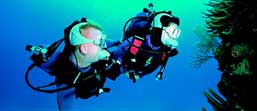Tutorial: Communicate Underwater

Scuba divers use hand signals and writing slates to communicate with their buddies. Photo courtesy of Stacy Kim, NSF Antarctic Biology Class.
Have you ever tried talking to your friends underwater? If so, you have discovered that it didn’t work very well. Even though sound travels well in water, our vocal cords are not designed to generate underwater sound. How, then, can people use sound to communicate underwater?
Scuba divers are trained to use hand signals to communicate with their buddies. They also use underwater writing boards, which allow for better communication. Both of these techniques require light, however. But what if the water is murky? Or if it is nighttime? Or if the divers are too far apart to see one another clearly? Is it somehow possible to use sound instead? Special underwater communication systems have been developed to allow divers to talk to each other underwater. A transducer is attached to the diver’s face mask, which converts his or her voice into an ultrasound signal. A fellow diver has an ultrasound receiver, which accepts the signal and converts it back to a sound that the diver can hear, allowing for communication. The same system can be used for communication between the diver and a surface ship.

Acoustic communication systems allow divers to talk to each other underwater. Image courtesy of Divelink.
An acoustic modem is used to transmit data underwater, much as telephone modems are used to transmit data over phone lines. An acoustic modem converts digital data into special underwater sound signals. These signals are then received by a second acoustic modem and converted back into digital data. Acoustic modems can be used for underwater telemetry, Autonomous Underwater Vehicles (AUV) command and control, diver communications, underwater monitoring and data logging, and other applications requiring underwater wireless communications.

Courtesy of Link-Quest Inc